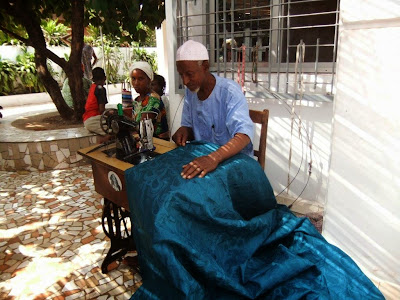The art of batik making is as ancient as it is varied so it was with great intrigue that I went along with a group of women folk to try my hand at batik making yet again (last time was in Lome, Togo 2012). All my crafty stuff lies gathering dust and goodness knows what else in a storage shed, my hands are idle and my creative ideas remain just that. So I grabbed at the opportunity to have another go at batik making, this time in Conakry, Guinea. On this steamy day we packed into a land rover and headed out into the dusty yonder to arrive at a compound where we were greeted by a lovely lady with amazing English, acquired by living in, you guessed it, England. Her family runs a successful batik making business and I can only admire their tenacity and smarts for making a go at something within a country where the pitiful economy is at a standstill.
 |
I cannot tell you how exciting is was for a bunch of women to find an actual shop!! The shopping beast within me was unleashed as I ran gleefully from one exquisite batik article to another. Yippee!! |
 |
One of the employees making batik items for sale. Everything is made slowly, painstakingly from scratch, by hand, using traditional methods. |
 |
This is how it is done.....the idiots guide to this type of batik making by someone who has done it |
 |
We were each given a piece of fabric, about the size of a small tablecloth. Then we chose some stamps we liked to form our design. |
 |
Then we dipped the stamps in the molten wax and stamped them onto the fabric where we wanted them placed. The fabric already had a pattern inlaid into it. |
 |
Next some dear ladies sat in the blazing sun with a little bucket of boiling water and removed any excess wax and our mistakes. |
 |
Ta da! The finished product-the dye does not run where the wax stamp has left it's imprint. Easy hey? Mine is the blue one with the flowers. |
 |
What about the wax? I'm so glad you asked! After the dye dried, the fabric was put into a pot of boiling water and stirred around and wrung out many times over to melt the residual wax. |
 |
Now for something a little more advanced (obviously not for us)-multicolour batiks. First the fabric is dyed and then it is scrunched up in a very specific way that is way harder than it looks. |











No comments:
Post a Comment